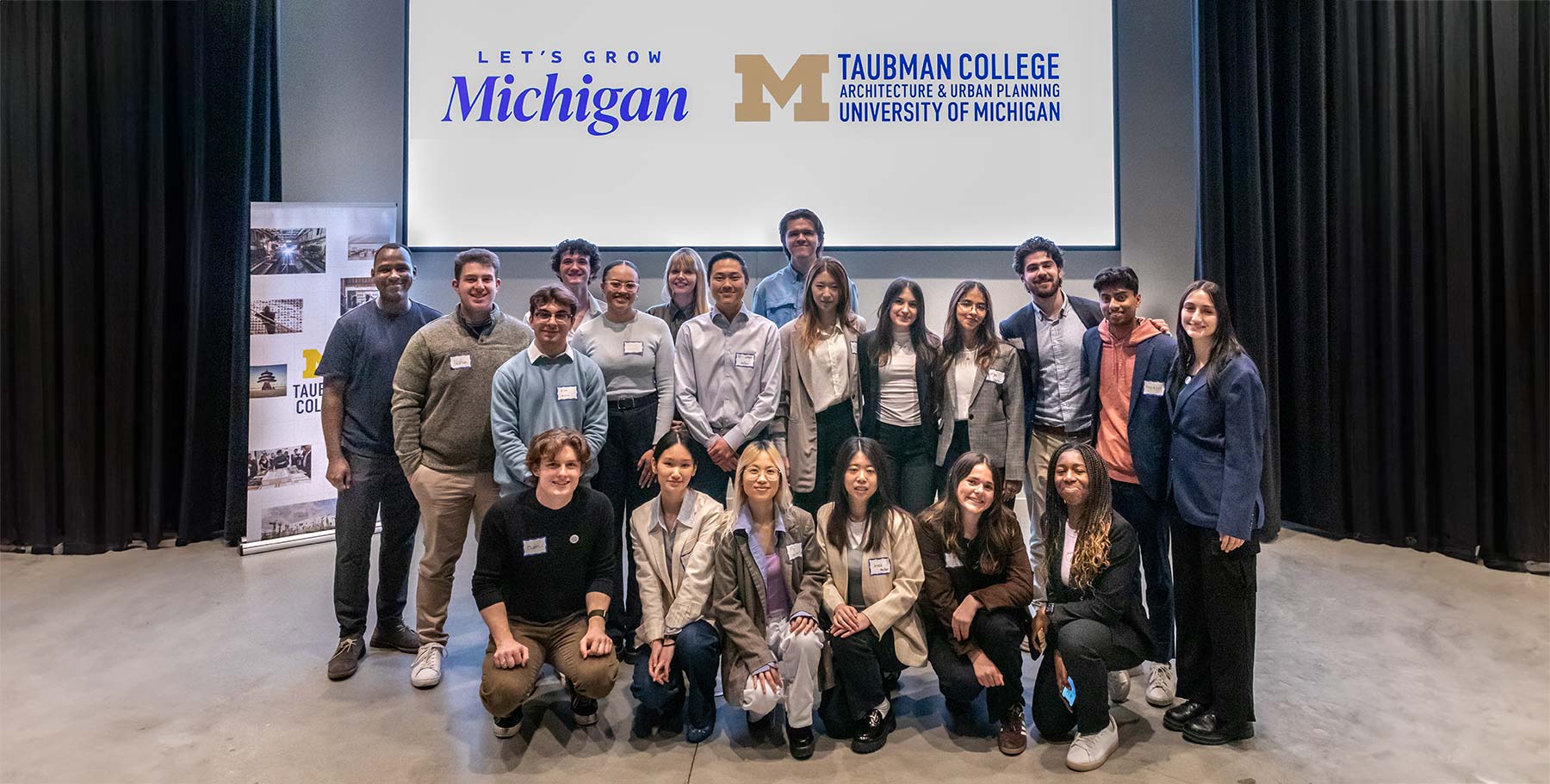The 2011 ULI/Gerald D. Hines Student Urban Design Competition team finalists were announced on Feb. 23, 2011, and of the four finalists, two were University of Michigan teams. This is the first time the University of Michigan has had two teams named as finalists at the same time since the competition originated nine years ago. The other two finalist teams competing against University of Michigan are from the University of Maryland and University of Oklahoma. MIT, Harvard University, University of California at Berkeley; University of Pennsylvania and University of Oregon received honorable mentions.
A $50,000 prize will be awarded to the winning team and each of the remaining three finalist teams will receive $10,000. This year, applications were submitted from 153 teams representing 60 universities in the U.S. and Canada. Nine teams entered from the University of Michigan.
“The majority of the submissions dealt with the issue of connectivity – specifically, how best to create a linkage through the entire site,” said Jury Chair James A. Ratner, chairman and chief executive officer, Forest City Commercial Group, Cleveland, Ohio. “The teams took the issues of sustainability and affordability very seriously, addressing both in their plans. Clearly, development that is sustainable and accessible to a broad income mix formed the core of the work from these students.”
University of Michigan submissions and finalist teams included:
Rainier Valley Exchange: “Rainier Valley Exchange” is a locus for transit, cultures, and businesses distributed appropriately on a new street grid that completes the existing pattern. This overlay promotes permeability and integration with the neighborhood and maximizes the development’s town-center functions.
Team:
Christopher Canna, Master of Urban Planning
John Drain, Master of Urban Planning & Real Estate Development Certificate
Koben Calhoun, Master of Urban Planning & Master of Public Policy
Dustin Sommer, Master of Architecture & Real Estate Development Certificate
Matt Nickel, Master of Architecture
David Bieri, Faculty Advisor
View submission here.
H.O.U.S.E.S.: “H.O.U.S.E.S.” reorients the site to Rainier Avenue with a strong block pattern, effectively calming traffic throughout the district. The theme of creating a healthy integrated community was consistent throughout, showing a thoughtful and well-communicated conceptual framework.
Team:
Sara Hadavi, Ph.D. in Landscape Architecture & Environmental Design
Aditya Inamdar, Master of Urban Design
Alex DeCamp, Master of Urban Planning & Real Estate Development Certificate
Amir Hajrasouliha, Master of Urban Design
Michel Banna, Master of Urban Design
Douglas Kelbaugh, Faculty Advisor
View submission here.
The interdisciplinary teams of students were challenged with creating a design and development proposal for a 33.5 acre site around the Sound Transit system’s Mount Baker light rail station. The Mount Baker Station, situated in the Seattle’s North Rainier neighborhood, is a key station that will likely define how the city will approach the opportunity to create more sustainable and transit-rich neighborhoods in the coming years. Students were challenged with devising a scheme that not only transforms and brands the neighborhood with an identity, but also serves as a benchmark for future development in the Greater Seattle region.
The competition is based on a hypothetical situation that addresses Seattle’s traffic congestion and sprawling network of auto-oriented neighborhoods and infrastructure. The Mount Baker station, at the intersection of Rainier Avenue and Martin Luther King Jr. Way, is surrounded by property that is currently being used for large parking lots, two heavily-traveled thoroughfares, and single-family detached residential properties. The assumption made by the competition is that the property owners realize how this station might be a “game changer” in how the city embraces new transit-oriented development.
“Taubman College invested substantial resources in its physical planning, urban design, and real estate development instruction and research, and worked diligently to promote collaborative, interdisciplinary work within the college and across other schools at UM,” said Richard K. Norton, Urban and Regional Planning Chair at Taubman College. “The Urban and Regional Planning Program made concerted efforts to grapple with the issues of sustainability and social equity throughout its curriculum. The recognition of two UM teams as finalists in this year’s Hines Competition highlights the progress made in the program.”
The teams received information about the site on January 18 and made their submissions by Jan. 31. Site visits will occur by finalist team representatives on March 11, 2011. The teams will make final presentations to a jury on March 31, 2011.
“Each team has shown strength in interdisciplinary approaches that bring together urban planning, real estate development, urban design, architecture, and landscape architecture to propose imaginative solutions to the site’s challenges–just as the Hines Competition intends,” said Margaret Dewar, Urban and Regional Planning Professor and Real Estate Certificate Program Director. “We are all rooting for their success in the next phase of the competition!”
In addition to Jury Chair James A. Ratner, other jury members include: Martha Barkman, senior project manager, Harbor Properties, Seattle, Wash.; Dana Behar, president and CEO, HAL Real Estate Investments; Seattle, Wash.; Mimi Burns, principal, Dekker/Perich/Sabatini, Albuquerque, N.M.; Tom Cody, founder and managing partner, Project, Portland, Ore.; Brian Cullen, founder and chair, Keane Enterprises, Inc., Washington, D.C.; Boris Dramov, principal, ROMA, San Francisco, Calif.; Bonnie Fisher, principal, ROMA, San Francisco, Calif.; Richard Heapes, co-founder and partner, Street-Works, White Plains, N.Y.; Jim Heid, founder, UrbanGreen, San Francisco, Calif.; Jeffrey D. Kune, managing director, BeaconRock Group, LLC, West Palm Beach, Fla.; Michael Lander, founder and president, Lander Group, Minneapolis, Minn.; and Peter S. Stone, senior vice president, ING Clarion Partners, Seattle, Wash.
Visit the competition’s website for more information.




